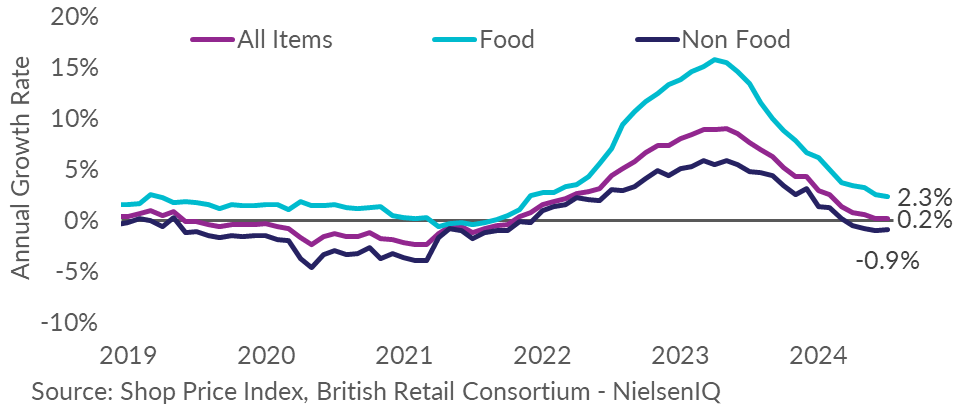Period Covered: 01 – 07
July 2024
- Shop Price annual inflation remained unchanged at 0.2% in
July. This is below the 3-month average rate of 0.3%. Shop price
annual growth remained at its lowest rate since October 2021.
- Non-Food remained in deflation at -0.9% in July, up from
-1.0% in the preceding month. This is in line with the 3-month
average rate of -0.9%. Inflation is at its lowest rate since
October 2021.
- Food inflation slowed to 2.3% in July, down from 2.5% in
June. This is below the 3-month average rate of 2.7%. The annual
rate continues to ease in this category and inflation is at its
lowest rate since December 2021.
- Fresh Food inflation slowed further in July, to 1.4%, down
from 1.5% in June. This is below the 3-month average rate of
1.6%. Inflation is its lowest rate since November 2021.
- Ambient Food inflation decelerated to 3.6% in July, down from
3.9% in June. This is below the 3-month average rate of 4.1% and
is the lowest rate since April 2022.
|
|
OVERALL SPI
|
FOOD
|
NON-FOOD
|
|
% Change
|
On last year
|
On last month
|
On last year
|
On last month
|
On last year
|
On last month
|
|
Jul-24
|
0.2
|
-0.1
|
2.3
|
0.1
|
-0.9
|
-0.2
|
|
Jun-24
|
0.2
|
-0.2
|
2.5
|
-0.1
|
-1.0
|
-0.2
|
Note: Month-on-month % change refers to changes in the
level of prices.

Helen Dickinson, Chief Executive of the British Retail
Consortium, said:
“Shop Price Inflation in July remained unchanged on the previous
month. Non-food price deflation continued, albeit at a slower
rate than June. Holiday makers could pick up bargain summer wear
and summer reads as clothing and footwear prices fell for the
seventh consecutive month amidst persistent weak demand, and the
prices of books fell. The 2023 declines in global food commodity
prices continued to feed through, helping bring down food
inflation rates over the first seven months of 2024. However this
shows signs of reversing, suggesting renewed pressure on food
prices in the future. Sports gatherings for Wimbledon and the
Euros benefitted from discounted snacking items such as crisps
and soft drinks.
“UK households suffered from high levels of inflation in 2022 and
2023 and can celebrate inflation levels returning to normal over
the first half of this year. But, with the outlook for commodity
prices remaining uncertain due to the impact of climate change on
harvests domestically and globally, as well as rising
geopolitical tensions, renewed inflationary pressures could be
lurking just over the horizon.”
Mike Watkins, Head of Retailer and Business Insight,
NielsenIQ, said:
“As we cycle through high inflation
comparatives from a year ago we can expect a lower level of
inflation for a number of months to come. But with the squeeze on
household finances continuing, consumer confidence only slowly
improving, and poor summer weather so far, retailers will still
need to keep any price increases to a minimum to encourage
shoppers to spend.”
